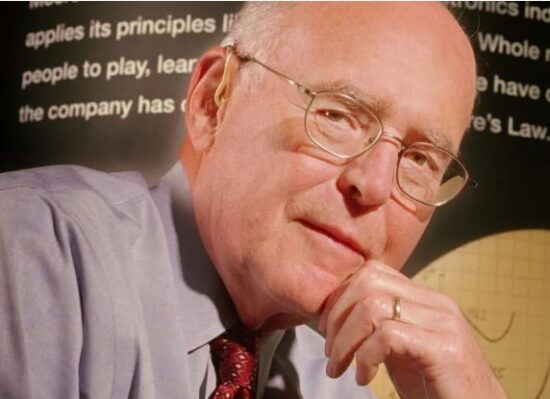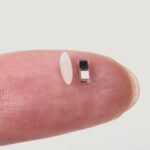If you are a computer nerd like me, then the last name Moore has meaning. Gordon E. Moore who died last Friday at the age of 94, was a cofounder of Intel, the semiconductor manufacturer who brought us the computer chip. In 1965 he put on his futurist cap and envisioned advances in chip performance that became known as Moore’s Law.
What did Moore predict?
He stated that silicon memory chips, which in 1965 contained 64 transistors, would double in capacity every two years. Intel used silicon wafers as the medium upon which to etch ever smaller transistors and circuitry. The doubling prediction turned out to be prescient with today’s memory chips featuring 20 billion transistors and some chips packing up to 90 billion.
This doubling turned the industry on its head leading to the first personal computers and today’s smartphones which have more computing power than high-end desktop systems from five years ago.
Moore’s Law: Meant to Inspire or A Vision of the Future
Silicon Valley got its name from silicon, the medium upon which the transistor and computing processors were built. The transistor milestones achieved along the way parallel what Moore envisioned and make for an interesting timeline:
- 1965 – Moore publishes an article in Electronics Magazine with his prediction.
- 1971 – Intel produces the 4004, a microprocessor with 2,250 transistors on board.
- 1972 – Intel introduces the 8008 with 3,500 transistors.
- 1974 – Intel introduces the 8080 with 6,000 transistors.
- 1976 – Intel introduces the 8085 with 6,500 transistors
- 1977 – The Apple II personal computer is introduced.
- 1978 – The Intel 8086 chip hits the 29,000 transistor mark.
- 1982 – The Intel 80186 chip puts 85,000 transistors on board. That same year the 80286 hits the 134,000 mark.
- 1985 – The Intel 80386 chip contains 275,000 transistors.
- 1989 – The Intel i960CA chip surpasses the 600,000 mark.
- 1989 – Intel produces the i860 processor surpassing the million transistor mark which gets put into the first generation of supercomputers.
- 1993 – Intel introduces the Pentium processor with 3.1 million transistors.
- 1995 – The Pentium Pro chip reaches the 5.5 million mark.
- 1997 – The Pentium II surpasses 8.8 million transistors.
- 1999 – The Pentium III features 21 million transistors.
- 2000 – The Pentium 4 hits the 42 million mark.
- 2003 – The Pentium M surpasses 77 million.
- 2004 – A new Pentium M reaches the 144 million mark.
- 2006 – The Pentium D achieves 362 million transistors. That same year Intel brings out the Itanium 2 chip with 1.7 billion transistors on board.
- 2007 – The Apple iPhone comes out with an onboard chip containing more than a billion transistors.
- 2008 – Intel creates the Xeon 7400 chip with 1.9 billion transistors.
- 2010 – Intel produces chips with more than 2 billion transistors onboard.
- 2011 – Intel chips hit the 2.6 billion transistor mark.
- 2012 – The Intel Xeon Phi chip hits the 5 billion transistor mark.
- 2016 – The Intel Xeon Phi chip hits the 8 billion transistors threshold.
For Intel, the period from 2016 onward to 2023 saw no significant increase in the number of transistors it could put on a single silicon chip. Other companies like IBM, Apple, AMD, Huawei, and Amazon continued to add more transistors as if they were trying to fulfil Moore’s prediction. Today you can find AMD EPYC Genoa chips with 90 billion transistors. Intel has the Sapphire Rapids chip with 48 billion, and the Apple M2 Max comes in at 67 billion.
Is The Industry Matching Moore’s Law?
From 1,000 transistors in 1965 to 90 billion in 2023, does that increase conform with Moore’s Law? The number falls well short of what Moore predicted although the doubling held up pretty well in the early computing years. By the second decade of the 21st century, however, it was no longer reflecting the possible because Moore’s doubling continued to 2023 would have meant 536 billion transistors, six times greater than AMD, eleven times more than Intel, and eight times more than Apple.
Why couldn’t the industry keep pace with the aspiration? Moore established a goal to inspire his company with industry-wide ramifications. But by the middle of the second decade of this century, shrinking transistors could only go so far. Today’s most advanced chips have transistors separated by a mere 5 nanometres. A human hair is 40 nanometres in thickness. Consider that shrinking a transistor to be smaller than a hydrogen atom is likely impossible unless someone can come up with a subatomic-sized transistor. So Moore’s Law has shrunk the transistor about as far as it can go which means not much wiggle room is left to add more to silicon chips.
Moore’s prediction made Intel the leader of the Silicon Valley computing revolution. He was a cofounder, and CEO from 1975 to 1987. When the biggest computer company in the world at the time, IBM, was ready to launch its first personal computer, the processor it chose came from Moore’s company. At one point in the mid-1990s, 80% of the world’s computers were running on Intel processors.
In the New York Times obituary that appeared in the paper last Friday, Silicon Valley entrpreneur, Harray Saal commented about Moore’s Law stating, “Any business doing rational multiyear planning had to assume this rate of change or else get steamrolled.”
Moore himself in 2000 in an interview said, “What I could see was that semiconductor devices were the way electronics were going to become cheap. That was the message I was trying to get across. It turned out to be an amazingly precise prediction — a lot more precise than I ever imagined it would be.”









[…] the semiconductor manufacturer, predicted in 1965 the rate of miniaturization which became known as Moore’s Law. It stated that the number of transistors that could be put on a silicon chip would double every […]